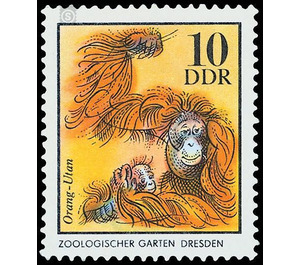zoo animals - Germany / German Democratic Republic 1975 - 10 Pfennig
Theme: Animals
| Country | Germany / German Democratic Republic |
| Issue Date | 1975 |
| Face Value | 10.00 |
| Color | orange |
| Perforation | K 13 1/2: 13 |
| Printing Type | offset |
| Stamp Type | Postage stamp |
| Item Type | Stamp |
| Chronological Issue Number | 1773 |
| Chronological Chapter | GER-DDR |
| SID | 810551 |
| In 35 Wishlists | |
Interesting animals from the zoos and zoological gardens of the GDR The Ministry of Posts and Telecommunications of the German Democratic Republic issues eight multi-colored special postage stamps with pictures of interesting animals from the zoos and zoological gardens of the GDR. Interesting animals from the zoos and zoological gardens of the GDR 10-pfennig value: Orang Utan, Zoologischer Garten Dresden The Dresden Zoo is the oldest zoo in the GDR. Its origins were popular bird displays of poultry breeders. The then created "Aktienverein Zoologischer Garten" soon acquired the livestock. A year later, on May 9, 1861, the zoo was opened on an area of 13 ha. Although good results have been achieved since then in the attitude of exotic animals, the zoo was awarded by Prof. Dr. med. Brandes (director from 1909 to 1934) with the introduction of a scientifically justified attitude of great apes a new profile. The first successful rearing of an orangutan born in captivity ("Buschi") brought the zoo a high international recognition. On 13./14. February 1945 sank with the city of Dresden and the zoo by Anglo-American bombs in a debris field. With the active help of the population, numerous companies and with the support of the state organs, it was soon possible to rebuild the zoo. With the deserving leadership by Prof. dr. Ullrich (director from 1950 to 1973) won the zoo again international prestige. Traditionally, the attitude of primates, especially apes, is in the foreground. Alone 10 orangutans were born in the zoo since 1962. Other 30 endangered species such as Addaxantilope, spectacled bear, tiger, mane wolves, etc. are held with good success. The livestock comprises about 2,000 animals in 500 different species. Through its extensive public relations, Zooschule and cultural-political effectiveness, the zoo has become a popular socialist educational institution. In 1974, 1.25 million visitors were counted.


